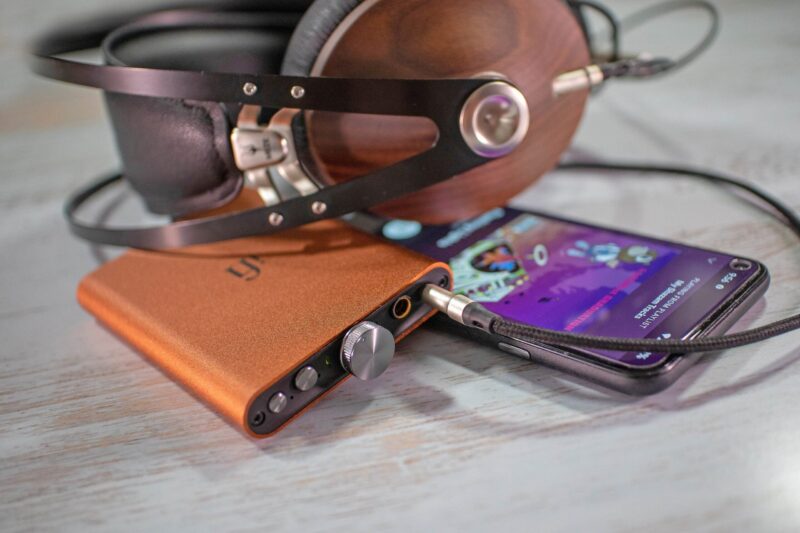TL;DR
With improvements in its detail and separation, the iFi hip dac2 is a worthy upgrade to the original.
Intro
Back in January of 2020, iFi dropped a new battery-powered portable amp that was slimmer and lighter than anything they had released to date. It was called the hip-dac, named as such because the design resembled a hip flask.
I felt the design was ingenious because the flask shape was a tried and tested concept of pocketability, plus it looked pretty slick. In my review, I raved about its ability to drive full-size headphones with enthusiasm, and I also loved the crisp, transparent sound.
I plainly wasn’t alone, because the hip dac has proven to be extremely popular. I talk to folks all the time who profess their love for its sound.
Well, at the beginning of this month, iFi unveiled the sequel, the $189 hip dac2. It’s $20 more than the original, and while the looks/features are pretty much the same (outside of a cool new orange paint job), the internals have received similar upgrades to its desktop cousin, the ZEN Dac V2 (our review here).
These enhancements are said to make the hip dac2 more transparent than its predecessor, as well as open the door for full MQA decoding, which the first one didn’t do.

So the question is with the first hip dac being so good, can the new one improve significantly on its ability to provide one of the best battery-powered DAC/Amp experiences for under $200?
Or,
if you already have the hip-dac, should you upgrade to the new one?
Well read on, and I’ll let you what I think!
Disclaimer: The review unit I have on hand is provided on loan by iFi Audio. No input has been given regarding the content contained in this evaluation. The hip dac2 will be returned at the end of my trial.
Specs
| Formats supported | DSD PCM DXD MQA | 256/128/64, Quad/Double/Single-Speed 384/352.8/192/176.4/96/88.2/48/44.1kHz 384/352.8kHz 384/352.8kHz |
| Digital Inputs | USB 3.0 Type ‘A’ (USB2.0 compatible) | |
| Headphone Outputs | Balanced S-Balanced (S-E) | 4.4mm 3.5mm |
| Power Output (@1% THD) | Balanced S-Balanced (S-E) | 400mW@32Ω; 6.3V@600Ω 280mW@32Ω; 3.2V@600Ω |
| Battery | Lithium-polymer 2200mAh | Approx. 8 hours |
| Power System | Charging via USB-C, BC V1.2 compliant up to 1000mA charging current and 6.3 volts | |
| Power (max) | <2W idle, 4W max | |
| Dimensions | 102 x 70 x 14mm 4.0″ x 2.8″ x 0.6″ | |
| Weight | 125g (0.28 lbs) |
Build/Features
So, as I said earlier, externally the hip dac2 looks almost exactly like the original, save the new metallic orange color. The size and weight, noted above, remain the same.
I was ok with the teal blue on the first hip dac, but I LOVE the orange on the new model. It just looks more premium to me, like those Audi R8’s that come in a similar color.
That said, features and power are the same, with output rated at 2.0V / 400mW @ 32 ohms via the 4.4mm balanced jack and 280mW @ 32 ohms via the 3.5mm unbalanced jack. iFi’s excellent XBass processing for bass boost returns as well, along with their PowerMatch 2-level gain control. They also use the same volume control pot.

On the rear of the unit, they have brought back their unique USB-A connector with allows the use of USB OTG cables as well as the Apple Lightning to USB Camera Adapter for connection to iPhones.
As with the first hip dac, the USB-A connector will not charge the battery (rated for 8 hrs.), for that you have to use the USB-C port next to it. Battery life is good, but watch out for a decrease in sound quality when the battery gets low.
As far as the DAC chip, the hip dac 2 uses the same Burr-Brown chip as the original and therefore supports the same audio files: PCM up to 32-bit/384kHz, and DSD 256 (11.2 MHz).
So What’s The Difference?
So far, I’ve spent a lot of time talking about the similarities between the first and second hip dac, so I’m sure you’re wondering about the differences.
Well, as I said before, the differences are mostly internal. To begin with, like the new ZEN Dac V2, the hip dac2 now has a 16-core XMOS processor/microcontroller pulled from the flagship Diablo and NEO DAC/amps.
This chip, which processes data received via USB, is now said to deliver double the clock speed and four times the memory of the old 8-core chip.
Because of the new XMOS chipset, the hip dac2 also becomes a full MQA decoder like the iFi Diablo, NEO, and ZEN Dac 2. This means that it does all the MQA processing inside of the DAC, and because of this, it can authenticate “MQA Studio” files, which are files where the sound is supposedly approved by the artist/producer or verified by the copyright owner.

A blue light on the front of the DAC signifies “provenance”, which in MQA parlance means you’re playing an MQA Studio file and hearing the exact sound that was approved in the studio.
The original hip-dac was just an MQA “renderer”, which means it could only play MQA files that were first decoded by software like the TIDAL app.
This is significant because there are very few battery-powered full MQA Decoders that are as compact and have the same level of power output as the hip dac2.
According to iFi, the new hip dac also has an upgraded crystal clock which removes more jitter or digital distortion than the one in the first model.
Sound
For my sound tests, I connected the hip dac2 both to my HP Envy X360 laptop and my Samsung Galaxy S21 Ultra using the included USB-C adapter. As far as headphones go, I used the $350 Hifiman SUNDARA, as it’s relatively neutral and matches up pricewise.
To test the output power, I also tried the Mr. Speakers AEON Flow Closed, which is tricky to drive. Without the PowerMatch gain engaged, it took about three-quarters of a turn on the volume knob to get them going.
However, with the gain button turned on, the hip dac2 needed less than a half-turn on the knob to get them up to a good listening volume. This amp should drive anything but the most inefficient planar headphones, which are probably not a good match for this battery-powered product anyway.
By the way, with the SUNDARA, I used it with PowerMatch turned off, and the volume knob just below a half-turn.

This was all via the Single-Ended output, so that should give you an idea of just how potent this amp is. For kicks, I hooked up the SUNDARA up to the balanced out just to gauge the power coming from there, and I barely got the knob up past a quarter-turn before killing my eardrums. That was on the low gain setting.
Tonal Balance
As with the first hip dac, the tuning of the hip dac2 DAC/Amp is overall pretty balanced, with a slight elevation in the upper mids and the midbass for a tad bit of warmth. For the most part, it doesn’t add anything to the music other than a little bit of sparkle up top. The perspective is decidedly forward, giving you a front-row seat at the show.
If you want a little extra warmth you can turn on the XBass, but it will come at the expense of a little bloom in the mids. I don’t think it’s necessary for the SUNDARA personally, but for headphones that sound a little too flat, XBass is the best at adding in some excitement without totally muddying up the midrange.
Detail
I liked the detail on the original hip dac, but the hip dac2 definitely has more crispness than the first one. Top-end detail and harmonics are extremely rich, with strings and vocals just a little more filled out on the new model than on the old one. It’s a similar experience to when I compared the ZEN Dac and ZEN Dac V2.

I guess the only thing some could say is that the new presentation borders on too analytical, especially with something like the SUNDARA, which trends that way with certain music. I don’t think so, I rather enjoy the crispness, although it can come across as synthetic at times, especially with Planars.
Soundstage and Imaging
As far as Soundstage goes, it has a stage that’s more deep than wide. But the depth was decent for a DAC/Amp under $200. It seems just a little bit deeper than the original hip dac.
When I listened to “Afro-Bossa” by Duke Ellington and his Orchestra, The width of the soundstage just went beyond the earcups and I could hear some decent layering from front to back.
The drums appeared clearly at the back of the stage, while the horns appeared up front on either side. The separation of elements in the mix had just a little more definition than on the original hip dac.
Listening to “Unplugged” by Eric Clapton, I was pleased with how well the hip dac2 placed the vocalist and background guitarists in their own little bubbles. I would say imaging is very good for the price point, with delineation approaching DAC/Amp combos in the next price tier.
I would’ve personally liked to hear just a little more soundstage width, but it was in no way a dealbreaker.
In General…
If you know what the first hip dac sounds like, then I wouldn’t expect wholesale changes in the overall sound signature, but instead a refinement of the sound with more transparency and detail. The second hip dac is a little more analytical than the first, but not to the point of fatigue. To me, the additional resolution allows the hip dac2 to pull out more music information which gives you a more vivid picture of what’s going on in a recording. At the end of the day, expect a more intimate performance with a lot of presence.
Comparisons
That said, I didn’t quite get the spatiality or separation of the $249 EarMen TR Amp which I also had on hand. On the hip dac2, the elements of the mix, while rich and detailed, felt a little more squeezed in, with everything placed almost on top of one another.

However, the hip dac2 sells for $60 less, and I would say it gives you about 90 percent of the TR-Amp’s separation. Not to mention it has a balanced output and full MQA decoding, which the EarMen amp doesn’t. It’s also a lot slimmer and lighter.
Compared to the $199 THX Onyx, which is a USB DAC/Amp in the same price range as the hip dac2, I felt the iFi had more focused imaging and better detail, but the Onyx had a wider soundstage.
The Wrap Up

If you’re looking for a battery-powered portable DAC/Amp combo under $200, the iFi hip dac2 is hard to beat. It has an excellent mix of features, remarkable power, and most importantly it sounds damn good. If you have the original hip dac, I wouldn’t say there’s a wholesale change to the sound, but I believe the additional detail and transparency make it worth the upgrade. Highly Recommended!
Hifitrends is reader-supported. When you purchase through links on our site, we may earn an affiliate commission. Prices are subject to change at any time.

I’m an audio writer who started as a young audio salesman/consumer electronics professional back in the late 90s. That’s where I discovered the magic of 2-Channel sound. My hunger for great sound has led me on a delightful music quest that continues today.



Leave a Reply